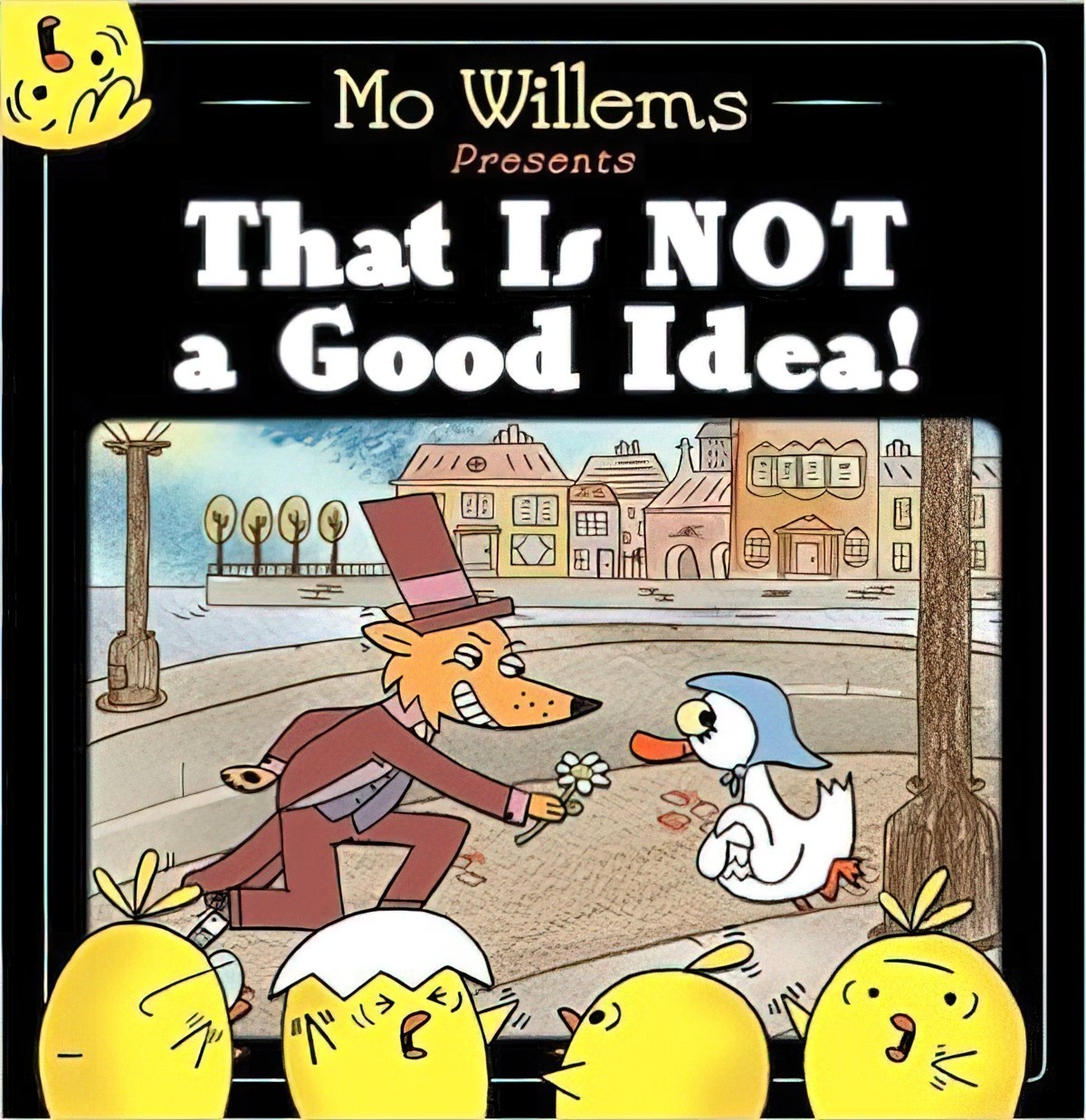That is NOT A Good Idea is a picture book written and illustrated by the Mo Willems team. This is a funny book which makes use of silent film techniques.
PICTUREBOOKS THAT BREAK DOWN ‘THE FOURTH WALL’
Some of my favourite picturebooks perform this trick of ‘a story within a story’. It’s a narrative technique. In novels for adults we often have an unseen narrator and we never really wonder who that narrator is, but in a picturebook you can give that narrator a personality, and you can even bring that personality into the story if it suits the plot.
We see it in Z Is For Moose, in which the animals are performing a stage play (for the reader).
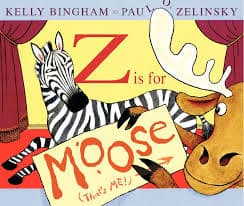
It’s a postmodern technique, and postmodern picturebooks are famous for being metafictive. (In which the reader is constantly reminded that this is a story.)
Another book which knocks down ‘the fourth wall’ between reader and story is David Wiesner’s revisioning of The Three Little Pigs.
Many parent reviewers point out that the silent film technique in this Mo Willems picturebook goes over the heads of children and exists for adult co-readers. I think this is only half true. Child readers will still pick up that this is a story within a story even if they don’t recognise the exact medium of silent film. The drawings of the narrator (the bird’s babies) are not really difficult for kids to understand.
SILENT FILM TECHNIQUES
On the colophon page we have a ‘List of Players’. These days we might see ‘Cast’ or ‘Starring’. This terminology (as well as the font) is from the silent film era.
The silent film era lasted from 1894 to 1929. The buildings, fashion and interior decoration is also from that period, with the Fox dressed up as a Victorian gentleman and the goose wearing a headscarf. (Not only is there a gender and species difference here, but also a class one.)
White words on black background, like tech websites from the early 2000s, unrelatedly.
Exaggerated gestures — the fox lifts his hat very high while the duck shows very obvious signs of coyness. This feature is common between silent film and picturebooks, so doesn’t really stand out.
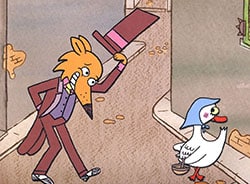
But Willems also borrows a Looney Tunes-esque technique: The dashed line to indicate line of vision:
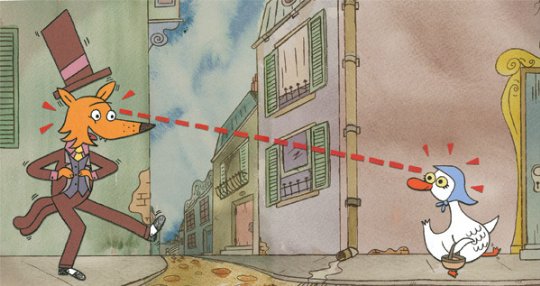
THE INFLUENCE OF AESOP ON POSTMODERN PICTURE BOOKS
Modern animal stories like these owe so much to Aesop. The narrative wouldn’t work if our culture hadn’t already taught us that foxes are cunning and ducks are vulnerable. (As my husband says of our chooks, “It’s their own damn fault for being so delicious.”)
As Perry Nodelman explains:
There are historical reasons for this concentration of animals who act like humans, among them the fact that some of the first stories considered suitable for children were the fables of Aesop, in which supposedly characteristic animal attributes are identified with human behaviour. These identifications still operate in picture books today. The image of a fox in The Amazing Bone immediately evokes the idea of craftiness, and in picture book after picture book, we are meant to understand immediately that the lions depicted are arrogant, the peacocks proud, the pigs gluttonous, the mice timid, the rats nasty. As Leonard Marcus says in “Picture Book Animals,” “animals as images in our everyday thought and expression are among the most association-rich classes of symbols. Just under the surface of picture book fantasies, cultural meanings may well be at work.”
– Perry Nodelman, Words About Pictures
Nodelman also points out that traditional (Aesopian) ideas about which personalities belong to which animals can be turned upside down, used ironically. He gives the example of Pearl the pig in William Steig’s The Amazing Bone. Traditionally, we expect pigs to be dirty and gluttonous, but Pearl is delicate and refined. Dr Seuss does a similar thing with Horton the elephant, who would normally break a tree by sitting in a nest. We see Horton’s bulk and don’t immediately expect him to be timid. Young readers learn not to judge characters based on their appearance.
Here, too, Aesop’s animal personalities are turned upside down. Although foxes often meet a sticky end due to their overconfidence even in Aesop’s fables, the goose turns out to be the wiliest of all.
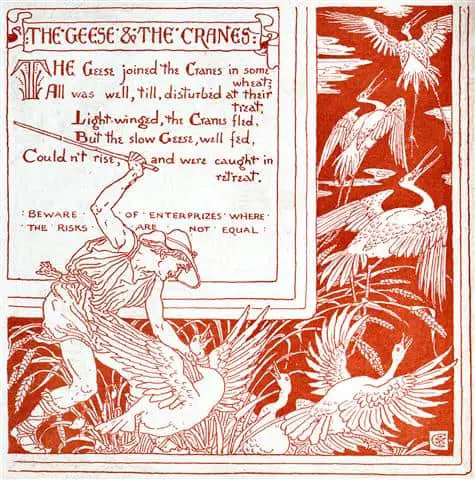
Here is a list of Aesop’s fables starring geese.
STORY STRUCTURE OF THAT IS NOT A GOOD IDEA BY MO WILLEMS
A story with a twist in the end makes you revise the entire thing. (For this reason we shouldn’t go about recommending books and films by saying ‘There’s a great twist!’) Hopefully anyone on this blog has already read the story, though.
SHORTCOMING
The fox thinks he’s smart but he’s not.
DESIRE
He wants to eat a goose for dinner.
(SECRET) OPPONENT
The goose.
PLAN
He plans to invite her home for dinner, pretending that she will be sharing the meal.
BIG STRUGGLE
Standing around the big pot, who will push who into the stew?
AUDIENCE SELF-REVELATION
The revelation happens for the audience, since the fox isn’t around to feel it. We see that the goose is not a weak little creature but is more wily than the fox.
NEW SITUATION
The fox is dead. The goose and her chicks are well fed.
FOR FURTHER INVESTIGATION
Another funny picture book which makes use of the techniques of silent film: Creepy Carrots.
A reviewer on Goodreads compares this Mo Willems picturebook to a novel for adults: Under The Skin by Michel Faber. (It’s also a film starring Scarlett Johansson.)
